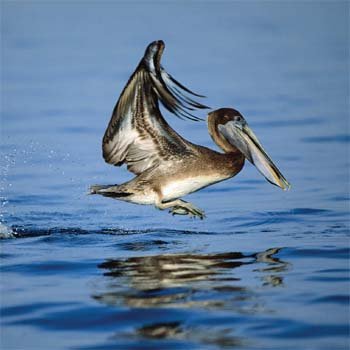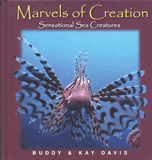Brown Pelican
Pelicans are the largest of all the aquatic birds and are famous for the large pouch of skin hanging from their lower jaw.

Pelicans are the largest of all the aquatic birds and are famous for the large pouch of skin hanging from their lower jaw. Eight species of pelican can be found in North America on the West Coast and in the marshlands of the southeast. The brown pelican lives along the coastline of California and Mexico inhabiting the rocks and cliffs near the warm coastal waters. They seldom fly far inland and do not go far from the shore out to sea.
The brown pelican is a large bird with brown-gray feathers overall and a wide white band on either side of its neck. The long beak is pale yellow with a pouch of bare skin beneath the lower jaw.
Sometimes brown pelicans gather in flocks of up to 50 birds to roost and feed together. They feed almost entirely on fish, which they catch by diving from heights of up to 65 feet (19.8 m). They plunge into the sea scooping up a beak full of water and fish. With the water in its pouch, it is too heavy to fly so it sits on the water’s surface, waiting for the water to drain away before it can swallow the fish. The sound of the splash as the pelican hits the water can be heard up to half a mile away. A series of air pockets in its chest help to cushion the force of impact and protect it from injury. The air pockets in the chest are part of the bird’s lungs.
Pelicans that live in freshwater lakes work in groups forcing fish into a school by beating their wings on the water. Then, using their beaks, they scoop the fish into their pouches.
The brown pelican mates in the spring, building its nest in shallow depressions on the ground, lining it with feathers, and surrounding it with a wall of soil. Some nest in trees, building their home with reeds on a stick platform. Both adults share in incubating three eggs for approximately four weeks. The chicks are naked when they hatch but have a coat of down within two weeks. The parents feed their young with regurgitated fish. The brown pelican has few enemies, but it is greatly affected by pesticides. The young are very vulnerable to predators, and occasionally an adult may be killed by sea lions or sharks.
Brown Pelican
Pelecaniformes • Pelecanidae
Pelecanus occidentalis
Length: 42–54 inches (105–135 cm)
Weight: 15–31 pounds (7–14 kg)
Life Span: 15–25 years
Special Design Feature: Pelicans use their pouch
to catch fish, not to carry them. They can scoop
up more than two gallons (8 liters) of water in
their pouch.
Did you know? The brown pelican can dive
from heights of up to 65 feet (19.8 m).
Marvels of Creation: Breathtaking Birds
This spectacular book brings the world of feathered creatures alive in a unique and colorful way.
Browse Kids BookRecommended Resources
- © 2024 Answers in Genesis
- Privacy Policy
- Contact
- About




